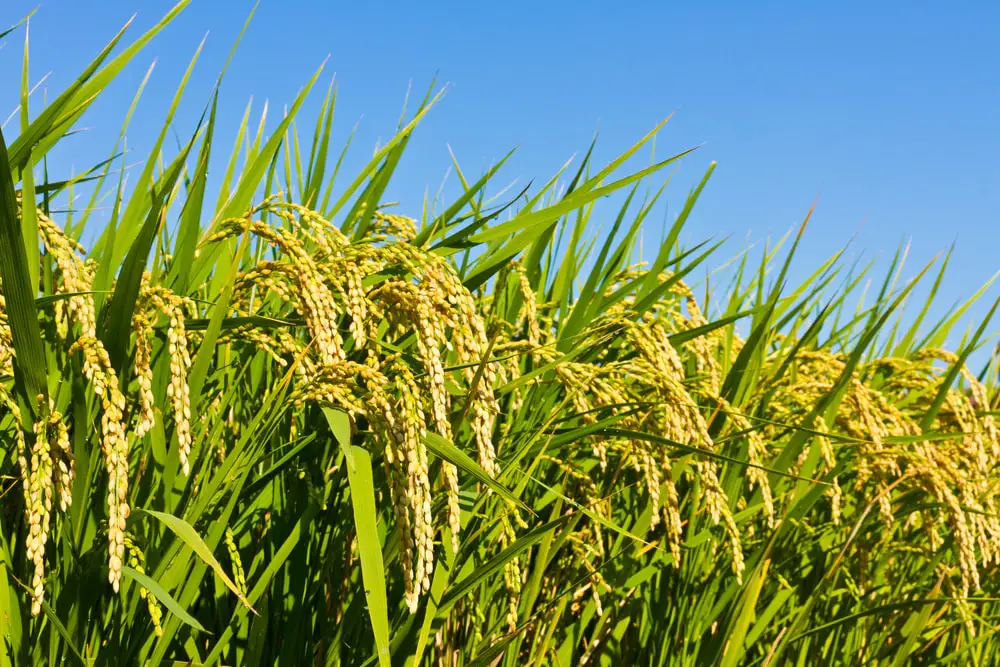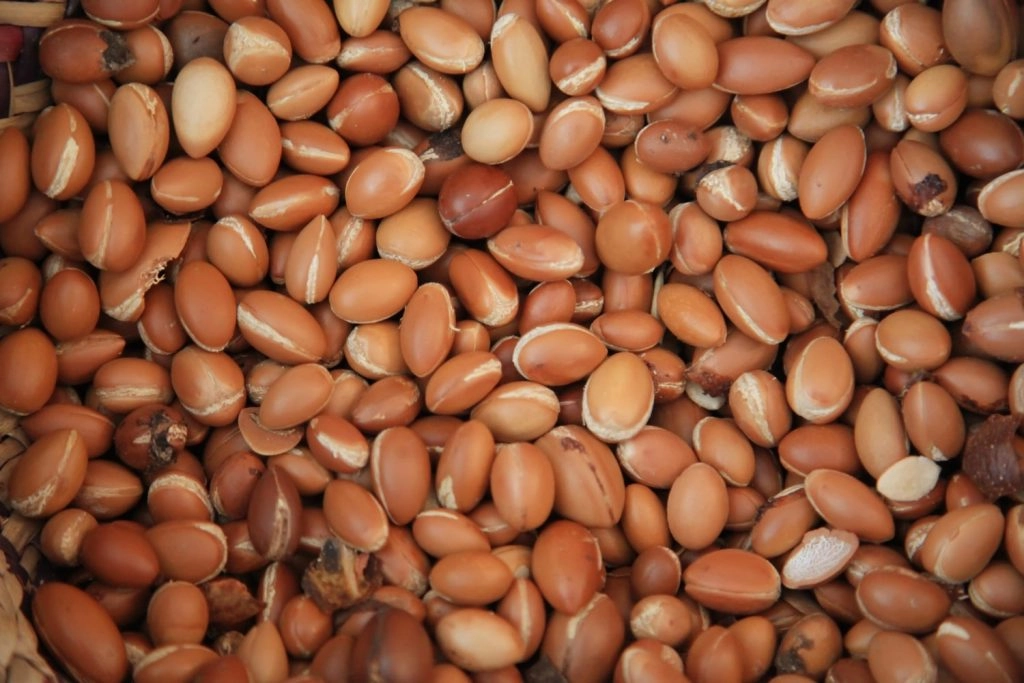As the name suggests, Oryza Sativa (Rice) Bran Extract is a nutrient-rich oil obtained from rice. It’s packed with antioxidants, vitamins, and numerous other natural elements that make it highly suitable for the skin.
This post may contain affiliate links. Read the full disclosure here
Here is everything you need to know about Oryza Sativa (Rice) Bran Oil, including its skincare benefits and whether it’s safe and good for your skin.
What is Oryza Sativa (Rice) Bran Oil?
Rice Bran Oil is also referred to as rice bran extract. This oil is extracted from the outer layers, namely the germ and inner husk, of the rice grain, called the bran. Typically, rice bran is produced as a byproduct of rice milling when the hull or bran of the rice grain is pressed.
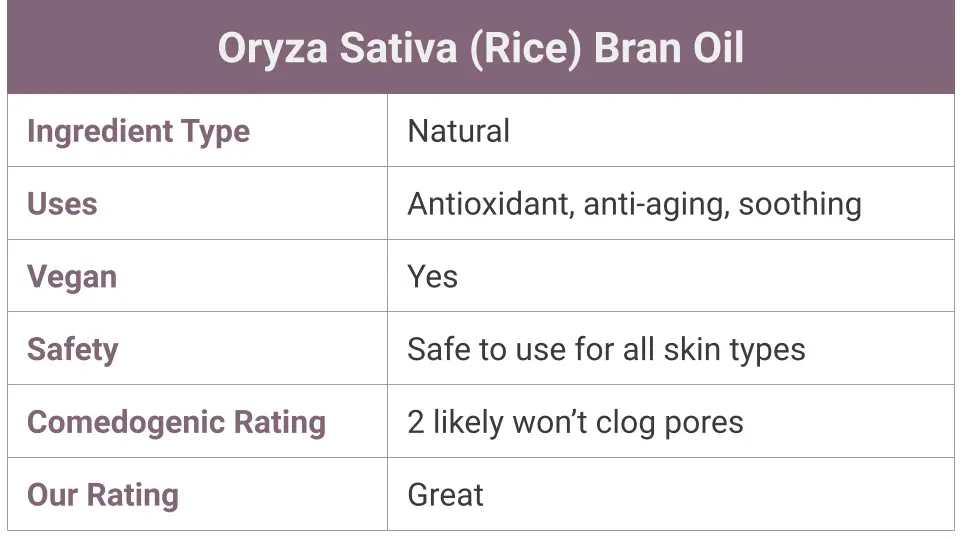
Even though it’s sometimes used as animal feed or discarded as waste, it has long been recognized for its wonderful skincare properties in Asian countries, such as Japan, India, and China. For instance, in historical times, Japanese women would wash their rice and then add the rice water to their baths later. They believed it kept their skin soft and smooth. The components in Rice Bran Oil give it its high nutritional value, which also makes it popular in Asian cooking.
However, there’s been a steadily growing interest in the potential health benefits of Rice Bran Oil in other areas of the world in recent years. The good news is, Rice Bran Oil is available in abundant quantities, so it’s an affordable yet effective addition to your skincare routine.
In a nutshell, studies have broken down the components in Oryza Sativa Bran Oil into a long list of bioactive compounds that include polysaccharides, proteins, antioxidants, minerals, vitamins, oils, and other phytonutrients.
Benefits of Oryza Sativa (Rice) Bran Oil for the Skin
The benefits of Oryza Sativa (Rice) Bran Oil from the skin are derived from its numerous individual components. Rice Bran Oil is rich in vitamin B, vitamin E, squalane, fatty acids, and more. It soothes, hydrates, protects the skin, and helps fight the signs of aging.
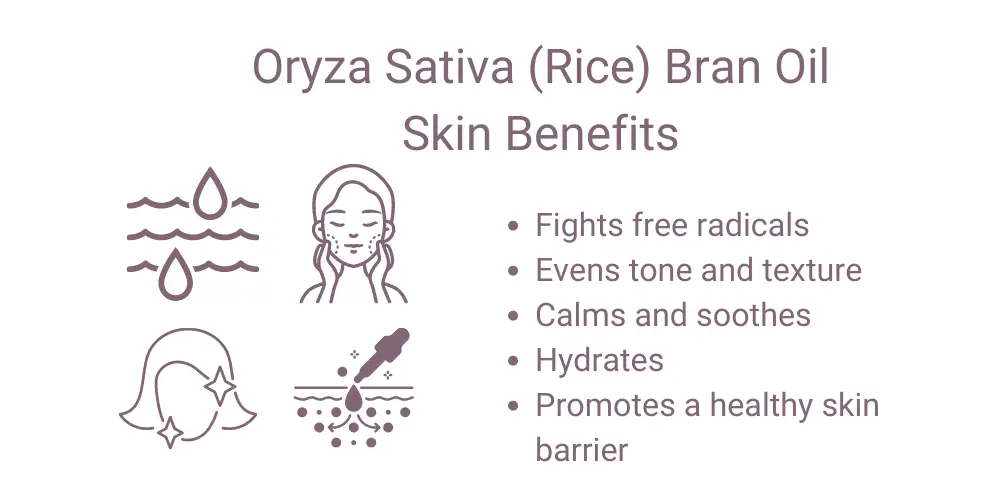
Vitamin B
Rice Bran Oil contains Vitamin B1/Thiamine, Vitamin B3 (Niacin), Vitamin B5 (Pantothenic Acid), and Vitamin B6, all known for their antioxidant properties. Antioxidants help to lessen the aging effects of free radicals, which are produced by natural body processes and environmental pollution.
Additionally, Vitamin B has a soothing effect on the skin and can help treat skin conditions like rosacea, hyperpigmentation, and eczema. It also helps the skin retain moisture, keeping it hydrated for longer.
Vitamin E
Vitamin E is a famous skincare ingredient that’s also found in Rice Bran Oil. Like Vitamin B, it’s anti-inflammatory and an antioxidant with anti-aging properties. You’ll find it used in sun protection and after-sun products to reduce skin wrinkling caused by UV – hydrates and alleviate skin redness and irritation. Overall, Vitamin E ensures a healthy, youthful, and radiant complexion.
Gamma (γ)-oryzanol
Oryzanol is an antioxidant with light-protective effects. It can treat uneven skin tones and hyperpigmentation and help diminish the appearance of dark circles under the eye by preventing the penetration of UV rays into the skin.
It also helps to strengthen the skin’s barrier by stimulating the sebaceous glands, making it suitable for dry skin. Oryzanol also has anti-inflammatory properties – it promotes circulation and reduces puffiness.
Squalene
Squalene is a component that easily penetrates the skin, keeping it moisturized and minimizing the appearance of wrinkles and fine lines. It also aids in cell regeneration, which keeps your skin youthful.
However, although squalene can benefit the skin, studies have shown that squalene’s chemical structure is susceptible to oxidation, which causes it to lose its potency. So, skincare products that claim to have squalene as one of the active products may not be as effective as advertised.
Ferulic Acid
Ferulic acid is a naturally occurring antioxidant found in many plants, including Rice Bran Oil. In addition, it has powerful antioxidant UV protective properties that keep the skin smooth and youthful by preventing free radical damage.
Fatty Acids
Essential fatty acids are an integral part of the skin. They’re the building blocks of cell membranes and help them to maintain a firm but flexible structure. Fat acids also ensure the skin’s barrier is well protected and that the skin retains enough moisture.
Rice Bran Oil contains linoleic and oleic fatty acids, which are polyunsaturated fats that keep the skin youthful by maintaining the oil barrier. Linoleic acid is also known as Vitamin F, and it’s an omega-6 fatty acid that helps prevent skin damage from UV rays and free radicals. Its anti-inflammatory properties also help treat skin inflammation. Overall fatty acids provide comprehensive skin benefits, which can also be experienced by consuming them.
These are some of the main compounds found in Rice Bran Oil. Keep in mind that Rice Bran Oil contains over 100 antioxidants, plus minerals, such as selenium, zinc, calcium, phosphorus, and zinc. Some of these components are also beneficial for the skin, but they’re too many to list.
So, let’s look at the skin benefits of Oryza Sativa (Rice) Bran Oil in a nutshell:
- Helps Keep the Skin Smooth and Youthful. Rice Bran Oil is a rich source of powerful antioxidants that help neutralize free radicals known to accelerate the effects of aging. Additionally, it helps lock in moisture into the skin, so it remains soft and smooth.
- Helps Treat Hyperpigmentation. Damage from UV rays can cause hyperpigmentation. Fortunately, Rice Bran Oil has light-protective properties that block UV rays from being absorbed by the skin, which reduces dark spots. It can also be used to help treat an uneven skin tone.
- Helps Treat Skin Conditions. Some compounds found in Rice Bran Oil have anti-inflammatory compounds that help to reduce irritation of the skin linked to conditions like acne and eczema.
- Helps Strengthen the Skin Barrier. Your skin’s protective barrier is made up of fatty acids that protect the skin and help it retain moisture.
Common Uses of Oryza Sativa (Rice) Bran Oil
You can find Oryza Sativa (Rice) Bran Oil present in many common skin care products, including the ones below:
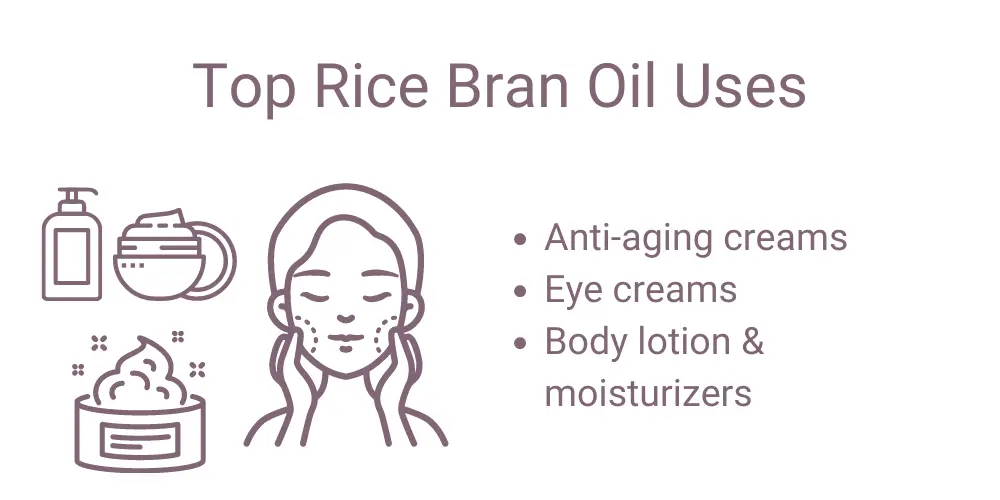
Anti-Aging Creams
Rice Bran Oil is a potent ingredient in many anti-aging creams since it offers protection against the sun. Too much exposure to the sun is well-known to cause irreparable damage to the skin in the form of fine lines and wrinkles.
However, using anti-aging creams containing Rice Bran Oil regularly can help prevent damage caused by the sun. Additionally, the powerful antioxidants in this oil help prevent free radical damage and accelerated skin aging.
Eye Creams
Rice Bran Oil can also help prevent dark circles under the eye, so it’s a regular ingredient in eye creams. This is a common problem, which can affect your overall appearance, making you look permanently tired.
Fortunately, when rubbed in the affected area, Rice Bran Oil can improve blood circulation and reduce any inflammation that’s causing puffiness. It also contains sterol, a compound that helps lighten the skin tone under the area, preventing dark circles.
Hand Lotion and Moisturizers
Because of its ability to help the skin retain moisture, Rice Bran Oil is also added to many moisturizers and hand creams. It’s normal for hands to come into contact with all sorts of substances, causing the skin to be dry.
In addition, most people tend to experience dry skin during winter. Using a lotion that contains Rice Bran Oil can keep your skin hydrated. Its fatty acids will ensure your skin’s natural barrier is protected at all times.
What’s the Comedogenic Rating for Oryza Sativa?
Comedogenic oils are those that clog your skin’s pores. The Comedogenic rating system involves a range, with 0 being an oil that won’t clog your pores at all and 5 having the highest likelihood of clogged pores. Oryza Sativa (Rice) Bran Oil has a comedogenic rating of 2, which indicates that there’s a moderately low likelihood that it may clog your skin pores.

So why is Rice Bran Oil’s comedogenic rating important? This helps anyone who suffers from or is likely to suffer from acne and blackheads decide which skin product is best for them. Generally, ingredients considered non-comedogenic have a rating of 2 and below, so Rice Bran Oil should be suitable for use if your skin is susceptible to breakouts.
However, it’s always best to consult with a qualified skincare professional or a dermatologist before doing so and immediately stop using the oil if you experience any adverse effects.
Is Oryza Sativa Safe for Skin?
As mentioned earlier, Oryza Sativa (Rice) Bran Oil is a key ingredient in many skincare and cosmetic products. However, before using Rice Bran Oil on your skin, it’s important to verify its safety.
Based on a scientific study, which analyzed the ingredients made from rice, Oryza Sativa, it can be concluded that Oryza Sativa (Rice) Bran Oil is generally safe for skin use. The study analyzed several cosmetic formulations containing Rice Bran Oil and was conducted on rats.
Overall, the study showed there was phototoxicity associated with the UV absorbing compounds found in mice. Furthermore, the ingredients were generally considered non-allergenic, and the concentration of heavy metals used in current products is well below the safe level.
The Cosmetic Ingredient Review Expert Panel also considers Oryza Sativa (Rice) Bran Oil safe to use in cosmetics based on current practices and concentrations.
Is Oryza Sativa a Good Ingredient in Skincare?
Oryza Sativa (Rice) Bran Oil has a very interesting profile that includes many bioactive compounds, but does this guarantee its effectiveness when used for skincare? This study showed that this might not be the case, especially if the Rice Bran Oil is not handled well during the refining process.
Organic Rice Bran Oil, however, manages to preserve beneficial constituents, such as fatty acids, oryzanol, and antioxidants. Interestingly enough, the study indicated that there might be a way to make sure the bioactive compounds in Rice Bran Oil do not biodegrade or deteriorate when processed.
In conclusion, the study found that skincare products that contained Rice Bran Oil in “trapped form” showed more potency than products without niosomes. (The Rice Bran Oil was encapsulated in niosomes, a substance used to prevent active ingredients from degrading).
Furthermore, Rice Oil Bran cream formulations that contained niosomes had a stronger hydrating effect. So, while Oryza Sativa may have all the properties of a good ingredient in skincare, keep in mind these may be lost during processing unless the Rice Bran Oil is in an entrapped form.
Frequently Asked Questions
Find answers to some of the most commonly asked questions about rice bran oil.
Related Articles You Might Like:

